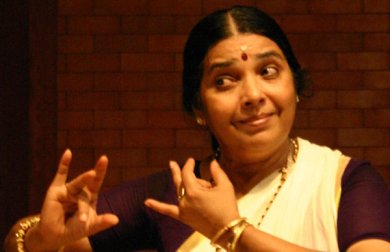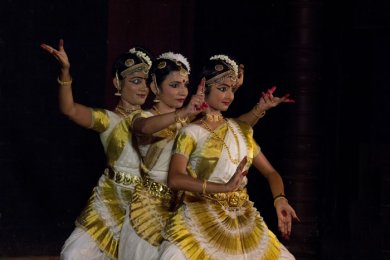
|   |

|   |
A novel form for Ashtapadi - Renu Ramanath e-mail: renuramanath@hotmail.com October 27, 2014 Legend has it that as the great poet Jayadeva rendered the eternal verses of his Gita Govinda, his wife Padmavathy danced in step with the lines, enacting the immortal scenes of Krishna’s divine romance. Later on, the Gita Govinda (Ashtapadi, in Kerala) inspired many dancers. The popular verses from the poem have been performed in the formats of almost all of India’s classical dance traditions. However, we do not yet know anything about the dance of Padmavathy, which form she used, was there a specific form at all, which steps she had used, or which mudras. There are evidences pointing at the existence of Ashtapadiyattam, an extinct form of dance through which Ashtapadi used to be performed. Nirmala Paniker, guru and scholar of Mohiniattam, had earlier conducted some research into that form. But what was getting revealed did not hold much attraction for her. The queries were pointing at a dance form that was hardly lasya oriented. Nirmala Paniker’s quest into the realm of dance had centred round exploring our rich and unexplored lasya traditions. Meanwhile, ‘Gitagovindam Nrithyalakshana Sahitham,’ a 200 year old manuscript containing instructions about performing Gita Govindam had been discovered from the Sarabhoji Saraswati Mahal Library of Thanjavur. It had happened a few years ago, and this event opened up entire new horizons for Nirmala Paniker. The acting manual for Gita Govinda found in that treatise had made use of hand gestures (mudras) from all the major treatises including Natya Sastra, Natyamanorama, Abhinaya Darpanam and Hasthalakshanadeepika among others. However, what attracted Nirmala Paniker was the use of certain gestures which were found in use in the Kerala style of dance. Though the treatise had surfaced a few years ago, the actual work of choreographing a portion of Gita Govidam could be realised only recently. Endless rounds of discussions, deliberations and research had preceded the work. It was decided to choreograph the first Ashtapadi of Gita Govindam as a Saptham of Mohiniattam. A Saptham (The Seventh One) is the seventh part of a Mohiniattam katcheri, following the Thillana and Slokam. Saptham in Mohiniattam is considered as the ‘natya’ part of the dance form. In other words, it is an item that will tell a story. During the olden days we used to have Siva Saptham and Rama Saptham. Rama Saptham is still performed, but Siva Saptham is no more taught. Slokam and Saptham are the two additional parts that have been included in the repertory of Mohiniattam after it got rejuvenated at the hands of Kalamandalam Kalyanikuttiyamma who is the guru of Nirmala Paniker. Nirmala continued with the journey, including the Slokam and Saptham in her own repertory taught at Natanakaisiki. Ten Sapthams have been choreographed at Natanakaisiki, with a group of young dancers being trained in them, the Gita Govindam (Ashtapadi) Saptham being the latest.  Nirmala Paniker
“A Saptham contains all the components of a complete Mohiniattam katcheri,” points out Nirmala Paniker. The Mohiniattam katcheri starts with a cholkettu which has a Devi stuti. Hence, the Gita Govinda Saptham also began with a Devi stuti. It becomes significant as worship of the goddess is a part of Kerala’s tradition, seen in all the traditional art forms. It also connects with the context of the Gita Govinda, as the poem begins by describing an overcast evening in the forest where the Gopis and the Gopas are worshipping Goddess Karthyayani. Seeing the darkening sky, Nandagopa asks Radha to hasten home, taking Krishna with her. As Radha and Krishna set out on their journey back home, Radha finds the child Krishna being transformed suddenly into a young man, who charms her. After the opening with the Ganapathi stuti, “Vakrathunda…” the three dancers, Parvathy Sreevallabhan, Anima VP and Sandra Pisharody moved into the Devi stuti, beginning with “Lokanathe…” Anima then withdraws from the stage, with Parvathy and Sandra continuing into the hymn, “Meghairmeduramambaram…’ which is the first sloka of Gita Govinda. The young dancers beautifully portrayed the Gopa’s trepidation and awe on seeing the darkening sky and the apprehension about the impending rain. After Radha watches Krishna turn into a young lad, they begin to explore the forest all by themselves. Then, the dancers portrayed the enchanting forest scenarios, with a peacock dance in which Anima joined again. The technique of Pakarnnattam was used to narrate the story, with the two dancers effortlessly portraying the different characters and the scenes unveiling around the forest as Radha and Krishna began their exploration of the picturesque forest on the banks of the Yamuna.  Sandra Pisharody, Parvathy Sreevallabhan  Sandra Pisharody, Parvathy Sreevallabhan, Anima Then started the actual verse, the famed Dasavathara Keerthanam “Pralapayodhi jale…” describing the ten incarnations of Lord Vishnu. The moments to represent each avatar were carefully chosen and perfectly enacted. The stress on abhinaya that Nirmala Paniker gives in the training at Natanakaisiki embellished the mellifluous movements of Mohiniattam. It could be felt without doubt that the addition of abhinaya, especially the Pakarnnattam technique, can greatly enhance the dance form, recapturing the spirit of the ancient dancers who were celebrated as having the ability to express with their whole body, as found in Pathittruppathu and Silappadikaram, the Tamil epics from Sangham period. After the Dasavathara Keerthanam, they moved onto the sloka, “Vedanudharathe...’ in which, obeisance was paid to all the ten avataras briefly. The performance wound up with a short Rasakreeda, to the verse ‘Viharathi Haririha…’ in which the other young students of Natanakaisiki also lined up. Other than Sandra Pisharody, Parvathy Sreevallabhan, and Anima VP, who presented the major parts, the young students including Hridya Haridas, Gayathri T Menon, Chaithanya N, Sreelakshmy T, Unnimaya S and Rudrapriya EV also joined in the performance. The music composed by Kalamandalam Jayaprakash and Neelamperoor Sureshkumar and rendered soulfully by Neelamperoor Sureshkumar moved between ragas from the Carnatic, the Sopana sangeetha and Hindustani traditions. Accompaniment was provided by Kalanilayam Prakashan (maddalam), Kalanilayam Ramakrishnan (edakka), Irinjalakuda Visakan (flute) and Murali Krishna (veena). Nattuvangam was by Guru Nirmala Paniker. Renu Ramanath is an independent journalist and columnist based in Kochi. Former Staff Reporter of The Hindu (1996 – 2007), she has been writing on art and culture, focusing on visual arts, film, architecture, theatre, music, dance and other classical performing arts since 1992. Recipient of Senior Fellowship in Theatre given by Ministry of Culture, New Delhi in 2013, she has been associated in coordinating major theatre festivals of Kerala. |